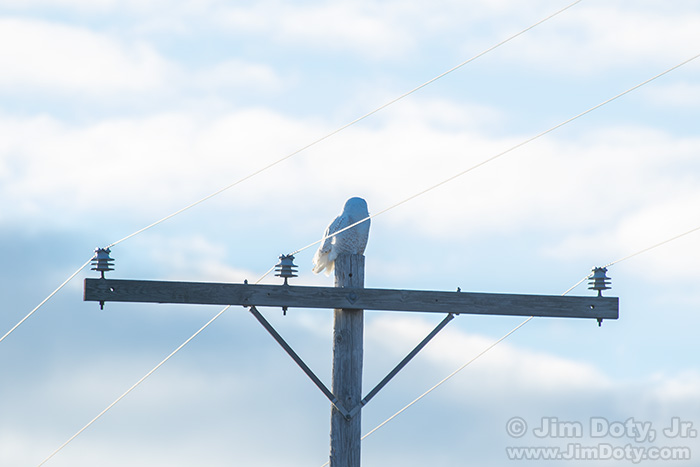When I am traveling with my highly trained and high paid photographic assistant it is his job to remove trash barrels when they are in the way, cut down trees that spoil my view, run out into the meadow and scare off the cow elk that are in front of the bull elk I want to photograph, rip boards off of old barns that don’t look quite distressed enough, pull on the whiskers of a sleeping cougar to wake it up, and cut down utility lines that are obstructing a clear view of my subject. But he wasn’t with me on this trip due to sitting in jail over a minor incident in Yosemite. So I had a challenge on my hands that I had to solve myself.
I am kidding, of course. The prior paragraph was inspired by really crazy things a few photographers do but shouldn’t be doing.
This is the fourth in a series of articles on Snowy Owl photography. Originally posted Mar. 2, 2016. Revised and re-posted January 17, 2021.
The light was great, the owl looked good, but the upper utility line was exactly where I didn’t want it to be. I was sitting in my car on the shoulder of the road and taking pictures out the driver’s side window. The quick solution was to get out of the car and change the camera height, but that would risk spooking the owl. I didn’t want to do that so I sat there for a while hoping the owl would change positions. As she looked around, the utility line would sometimes be just over or under her eyes, but still across her face. After 9 minutes of shooting I was ready for a change. (FYI: Male snowy owls lose the markings on their feathers as they mature and turn almost pure white while females retain the distinctive feather markings.)

Google Earth satellite map with the location of the owl on the utility pole (red “O”) and the photo locations for the three images in this article (P1, P2, and P3). The time each photo in this article was taken is also marked.
There was a nearby road that would allow me to photograph the owl from a different angle. so I drove there and tried again (red “P2”).
My new location removed the utility line from the owl’s face, but I was much farther away and the light was not nearly as good. And the owl showed no interest in looking my direction. So I gave up and went to location P3 which was very close to where I originally was.
I was at a slightly different angle but the utility line was still across the the owl’s face. I took some more photos and then decided the only way to solve the problem was to get out of the car. The key is to move slowly and carefully. And, as I mentioned in a prior article in this series, I use Dewitt Jones’ trick of talking to animals. I’ve been told snowy owls respond well if you sing Pagliacci to them, but I was not able to verify that bit of information.
When she looked away, I cracked the door and waited. The next time she looked away I opened the door a little farther and waited. The next time she looked away I put one foot out the door and on the ground. Each time she looked away I kept this process up until I was out the door and sitting on the ground with my back leaning against the car. The owl was calm and doing just fine.
By sitting on the ground the camera was at a lower angle than when I was shooting out the car window. This moved the upper utility line up and above the owl’s head. Now I had a great shooting angle. I rested my elbows on my knees to give myself as much stability as possible and took pictures. This photo was taken 20 minutes after the photo at the top of this article.
I didn’t like the upper utility line angled across the top of the image. I decided it was a distraction so I digitally removed it in post processing. That was an artistic decision. If I were to send this image to a newspaper, the National Geographic, or any other publication with a “no-retouching” policy, I would submit the original version with the upper utility line still visible.
The Snowy Owl Series
How To Series: Snowy Owl Photography – An Overview
More Links
How To Series: Winter Photography – An Overview with article links
Related Article Links
Metering Wildlife in the Snow, Part One
Metering Wildlife in the Snow, Part Two
How To Find Wildlife, The Best Books
How To Photograph Wildlife, The Best Books
How to Be A Better Wildlife (and Nature) Photographer
If you want to spend a weekend learning how to be a better nature photographer, I do workshops and photo safaris each year in Colorado and/or Michigan. You can find my next workshop at JimDoty.com.




